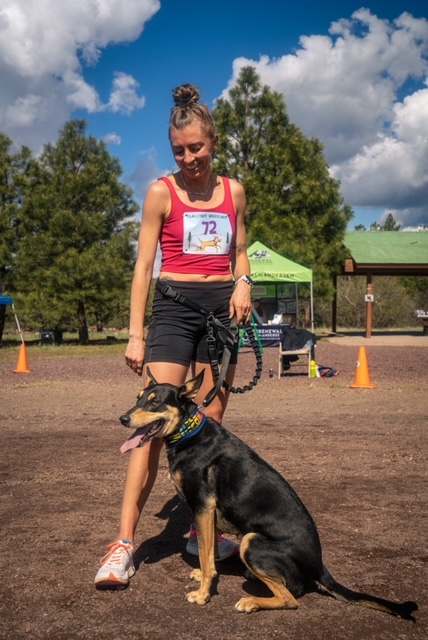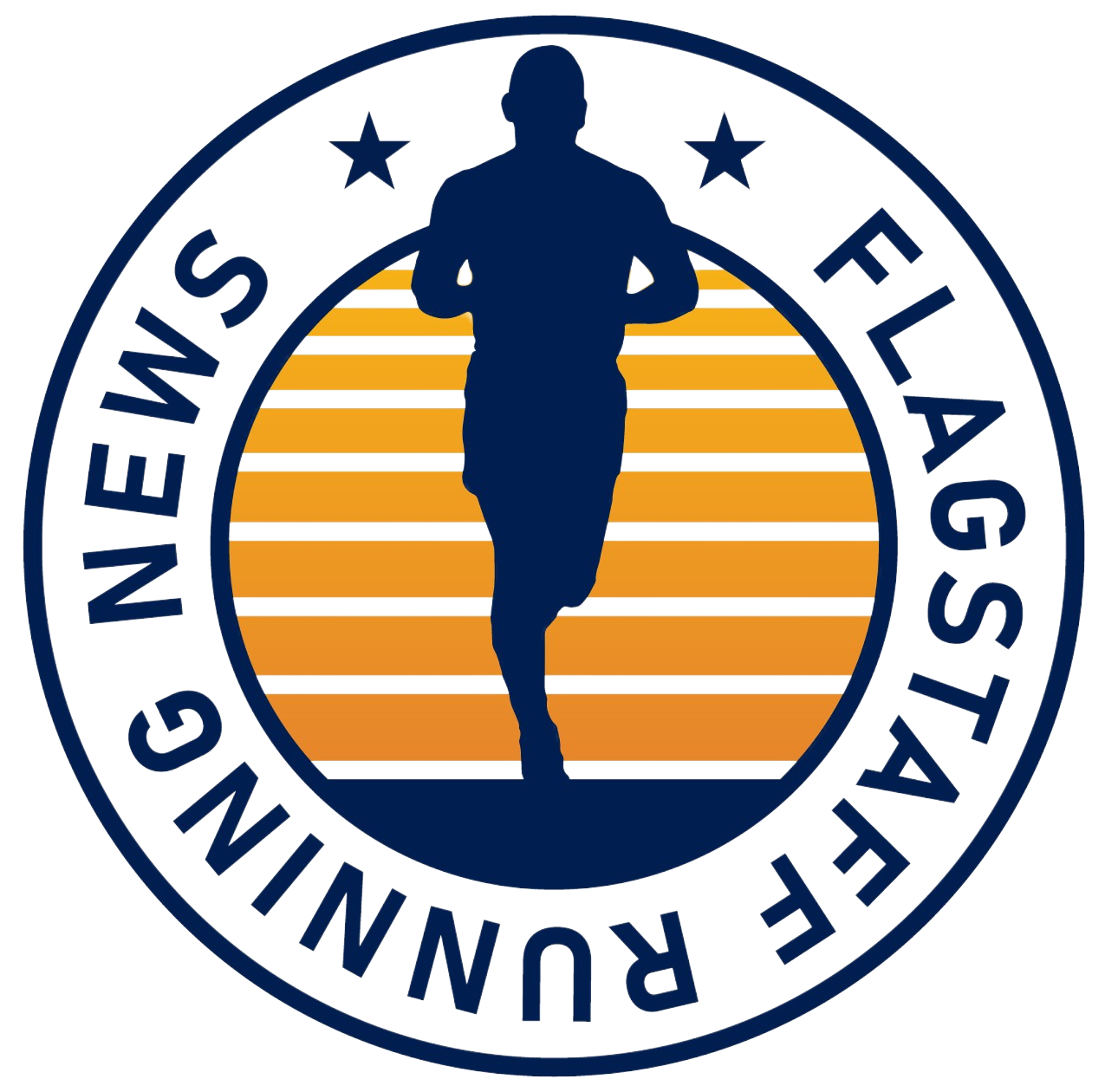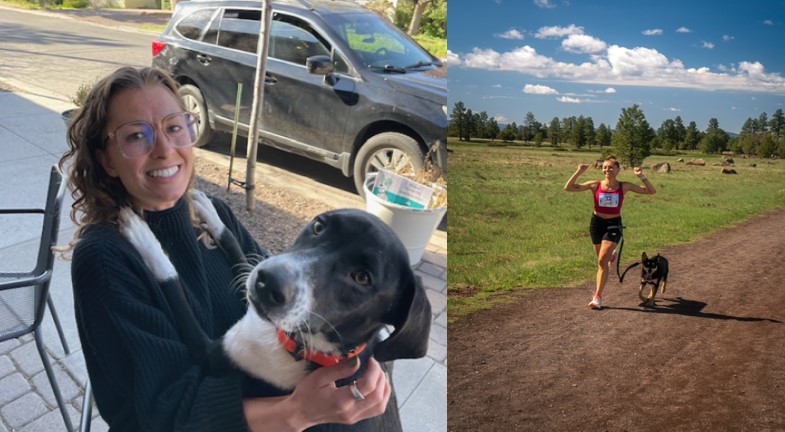Oliver is young and hasn’t run for very long, nor very far. His pacing could use some work. He needs to shake that habit of going out too fast and remember to run the tangents. But he’s got innate speed and good turnover and, most importantly, he loves to run and approaches the endeavor with unbridled joy.
So, yeah, Oliver seems ready to tackle his first race on Saturday, following several months in something of a Kennel-to-5K program.
Oliver, of course, is a dog.
A handsome, 11-month-old rescue from the rez with boundless energy and an outgoing personality, he has been training for a few months with dog mom/running partner Addison Royer and progressed enough that the two will take the plunge and enter this Saturday’s Flagstaff Doggie Dash and BuffaLoops Ultra at Buffalo Park.
It will be an exciting experience for Oliver, and a bittersweet one for Royer.
Royer is a past winner of the Doggie Dash, but she did so with her beloved rez dog Lilly, who died last fall at only age 3 after a mysterious illness that compromised her neurological system. Lilly, Royer says, was not only a great “adventure dog,” but a damned good runner, being a mix of cattle dog and German Shepherd (according to DNA tests).
What Royer remembers best about Lilly was her joie de vivre out on the FUTS or the singletrack trails, the way she used to begin each run with a series of barks, as if to announce “let’s go” before settling into a brisk canter, and her adorable but sometimes annoying habit of trying to herd Royer on the runs.

Too soon to tell, obviously, whether Oliver will reach the same heights of running acumen as Lilly. But to Royer, it really doesn’t matter. She just likes running with dogs – from long runs to recovery jogs, everything but interval “workouts” – and the dogs like running with her.
As of Monday, 39 canine-human pairs have signed up for the Doggie Dash, which also features a human-only 5K and the BuffaLoops Ultra 12-hour, 6-hour, and 3-hour races. Clumping together so many sniffing, drooling and excitable dogs at the starting line and telling them to all start running together may seem chaotic, and it is, but in a good way.
We’d like to say that no one takes this race seriously, but we can’t, because in past years, serious runners and their humans have lit out on the course as if it were the Olympic Trials. Royer said her plan to avoid the traffic jam when she and Lilly raced was to start fast and then keep going fast and finish fast.
Well, actually, that was Lilly’s plan. Royer was just at the other end of the leash.
“I feel like it would’ve been harder (racing) if we were in the mix of things (the pack),” Royer said. “She liked to get out fast, and I’m a stronger enough runner that it was fine. She loved to be in the lead. She’d come to group runs with me and I’d bel like, ‘I don’t really want to run 7-flat pace with all the fast college guys, but you want to be in the lead, Lilly, so we’ll figure it out.’”
Royer, a former collegiate soccer player, has always enjoyed running and, when she decided to adopt Lilly from the Coconino Humane Association, she entertained the idea of training her to run alongside her.
“It started out with short runs,” she recalled. “And she loved it. The FUTS is really nice for soft surfaces. So is Buffalo Park. But it’s a very big learning curve when you start running with dogs, especially when they love it and have got the herding dog (instinct) in them.”
At first, she recalled, Lilly thought it was her job to keep Royer in line, not the other way around. With time, she understood her role, but still that herding instinct would occasionally kick in.
“You’re a fast moving object, so she would jump up kind of, not really, nip at the thigh,” Royer said. “We worked with the leash on walking and then exposure to running. The more you do it, the more they figure it out. Like, ‘Oh, if I’m acting like a fool, we aren’t going to go for very long. We’re going to go home because Mom’s mad.’”
Control is vital for the human running partner, Royer said. You never know when a squirrel darting across the path or some enticing dead animal carcass might make rev up the dog from a steady trot to a full-on sprint.
“When I first running with Lilly, I was just using a SpiBelt (around her waist) and carabinered the leash to it,” Royer explained. “I’ve never liked running holding anything in my hand, so I did that, just so I could do my regular arm swing. Now, I have Stunt Puppy (hands-free leash), a bungee cord on it with a leash. It lets them have a little bit of pull without affecting your stride.”
Lilly built up enough endurance to run 16 miles, though Royer said often the runs were much shorter.
“We build up to it slowly,” she said. “We do plan it well in the summer with water.”
Eventually, Lilly became quite the aerobic animal, which shocked Royer even more when the dog took ill after what she describes as a routine walk.
“They don’t quite know what happened,” Royer said. “She went on a walk with me after work and afterward started exhibiting neurological symptoms. Initially, they thought she ingested something. She was at the ER vet overnight, seemingly doing better. Over the next week got worse and worse.”
After a grieving period, Royer and boyfriend James Wilde decided to adopt another dog. They purposely did not want a dog that looked too much like Lilly — the coloring, the markings, the “bat” ears and distinctive eyebrows.
Enter Oliver, another mutt, but with a blacker coat and white paws, though the same adventuresome spirit as Lilly.
At the start, though, Oliver had to overcome some health problems before hitting the roads and trails with Royer.
“We went to Coconino (the shelter), and it was his first day there,” she said of Oliver. “He had parvo. He’d just gotten fixed. Then, when we got him home, he had giardia and worms, unbeknownst to us. But he was just the tiniest sweetest little guy.”
Now, Oliver is healthy and much bigger – 52 pounds. And Royer’s experience with Lilly helped her get Oliver race-ready.
His first run?
“It was a mess,” she said, laughing. “But he loved it. He was so excited. I played soccer in college, so in starting to run with dogs, I have to use my soccer skills, the agility, the start-stop, the something-smells-good-here, I’m-going-to-stop-right-in-front-of-you thing.
“He’s done a lot better now. The most he’s done is five or six miles. We don’t want to rush into it. Our biggest hurdle is that he thinks every dog is his best friend. Better than the opposite. But I’m like, ‘No, we’re running right now, I’m not going to come to a dead stop and say hello.’”
Like Lilly, Oliver prefers a quick start — really, what dog doesn’t? – but he eventually settles in.
(Wilde) and I were debating whether he was emotionally ready or not (to race),” Royer said. “You know, to behave well enough. We decided to give it a shot and if it turns into a walk or something, that’s fine. But my guess is he’ll want to be out there in front.”
Royer’s advice for runners who want to break in a dog? Patience and consistent training.
“None of this is professional (advice),” she said, “but make sure they do decently well on leash before you introduce an element of speed to it. Start slow on soft pavement. I’d say the biggest investment is a good leash. I’ve never liked running with things in my hands, so holding a leash has not been fun. So, there are the waist belts. There’s also the stuff you can get for the sport of dog-pulling-human, almost like sled dogs, but (with) no sled. I feel like Oliver would that. But until he’s fully grown, I don’t want to put additional stress on his joints. I also don’t know if I’m well versed enough to teach him to pull.”
No matter where Oliver finishes among his canine competitors, Royer is sure of one thing: Oliver will enjoy himself.
“He just loves to get out there so bad,” she said.
Just like Lilly.


Leave a Reply